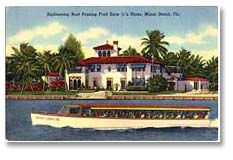 Sightseeing boat passing Fred Snite Jr.'s Home, Miami Beach, Fla. Sightseeing boat passing Fred Snite Jr.'s Home, Miami Beach, Fla.
Water transportation was one of the primary methods of
accessing the Miami area both before and after the arrival of the railroad.
Fishermen from the Bahamas were some of the first non-indigenous settlers in the
region who recognized the enormous potential for fishing along the bay as well
as throughout the Keys. Ralph Munroe was drawn to the area for the boating
opportunities it offered, and he brought many friends to Miami by touting the
pleasures of sailing the waters of the Caribbean from a base in Miami.
Developers took advantage of the natural waterways as well
as the man-made ones, by offering guests and residents alike the opportunity
for year-round boating. The Purdy Boat Company provided many Miami Beach
hotel owners, for example, with gondolas for rent so their guests could be
whisked along Biscayne Bay. Sightseeing boats offered yet another
opportunity to enjoy the beauty of the emerging Miami skyline from the
tranquil waters of the coastline. Steamships became a crucial part of
Miami’s development.
Once dredging work on Miami’s deep channel was completed in
1920, the stage was set for increasing tourist travel between the northern
Atlantic Coast, Miami, and Havana. Several steamship companies, including
the Havana-American Steamship Line, developed ferry services to Cuba as well
as the Bahamas, ushering in the beginning of the cruise industry. When Ted Arison launched Miami-based Carnival Cruise Lines in 1972, he drew on the
benefits Miami had accrued over the last fifty years as a leading site of
cruise departures and made Carnival into the largest cruise line in the
world.
|



